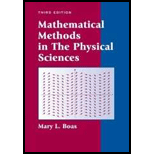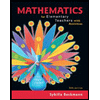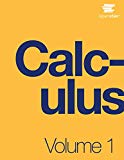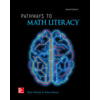
Mathematical Methods in the Physical Sciences
3rd Edition
ISBN: 9780471198260
Author: Mary L. Boas
Publisher: Wiley, John & Sons, Incorporated
expand_more
expand_more
format_list_bulleted
Textbook Question
Expert Solution & Answer
Want to see the full answer?
Check out a sample textbook solution
Chapter 14 Solutions
Mathematical Methods in the Physical Sciences
Ch. 14.1 - Find the real and imaginary parts u(x,y) and...Ch. 14.1 - Find the real and imaginary parts u(x,y) and...Ch. 14.1 - Find the real and imaginary parts u(x,y) and...Ch. 14.1 - Find the real and imaginary parts u(x,y) and...Ch. 14.1 - Find the real and imaginary parts u(x,y) and...Ch. 14.1 - Find the real and imaginary parts u(x,y) and...Ch. 14.1 - Find the real and imaginary parts u(x,y) and...Ch. 14.1 - Find the real and imaginary parts u(x,y) and...Ch. 14.1 - Find the real and imaginary parts u(x,y) and...Ch. 14.1 - Find the real and imaginary parts u(x,y) and...
Ch. 14.1 - Find the real and imaginary parts u(x,y) and...Ch. 14.1 - Find the real and imaginary parts u(x,y) and...Ch. 14.1 - Find the real and imaginary parts u(x,y) and...Ch. 14.1 - Find the real and imaginary parts u(x,y) and...Ch. 14.1 - Find the real and imaginary parts u(x,y) and...Ch. 14.1 - Find the real and imaginary parts u(x,y) and...Ch. 14.1 - Find the real and imaginary parts u(x,y) and...Ch. 14.1 - Find the real and imaginary parts u(x,y) and...Ch. 14.1 - Find the real and imaginary parts u(x,y) and...Ch. 14.1 - Find the real and imaginary parts u(x,y) and...Ch. 14.1 - Find the real and imaginary parts u(x,y) and...Ch. 14.2 - 1 to 21. Use the Cauchy-Riemann conditions to find...Ch. 14.2 - 1 to 21. Use the Cauchy-Riemann conditions to find...Ch. 14.2 - 1 to 21. Use the Cauchy-Riemann conditions to find...Ch. 14.2 - 1 to 21. Use the Cauchy-Riemann conditions to find...Ch. 14.2 - 1 to 21. Use the Cauchy-Riemann conditions to find...Ch. 14.2 - 1 to 21. Use the Cauchy-Riemann conditions to find...Ch. 14.2 - 1 to 21. Use the Cauchy-Riemann conditions to find...Ch. 14.2 - 1 to 21 . Use the Cauchy-Riemann conditions to...Ch. 14.2 - 1 to 21. Use the Cauchy-Riemann conditions to find...Ch. 14.2 - 1 to 21. Use the Cauchy-Riemann conditions to find...Ch. 14.2 - 1 to 21. Use the Cauchy-Riemann conditions to find...Ch. 14.2 - 1 to 21. Use the Cauchy-Riemann conditions to find...Ch. 14.2 - 1 to 21. Use the Cauchy-Riemann conditions to find...Ch. 14.2 - 1 to 21. Use the Cauchy-Riemann conditions to find...Ch. 14.2 - 1 to 21. Use the Cauchy-Riemann conditions to find...Ch. 14.2 - 1 to 21. Use the Cauchy-Riemann conditions to find...Ch. 14.2 - 1 to 21. Use the Cauchy-Riemann conditions to find...Ch. 14.2 - 1 to 21. Use the Cauchy-Riemann conditions to find...Ch. 14.2 - 1 to 21. Use the Cauchy-Riemann conditions to find...Ch. 14.2 - 1 to 21. Use the Cauchy-Riemann conditions to find...Ch. 14.2 - 1 to 21. Use the Cauchy-Riemann conditions to find...Ch. 14.2 - 1 to 21. Use the Cauchy-Riemann conditions to find...Ch. 14.2 - 1 to 21. Use the Cauchy-Riemann conditions to find...Ch. 14.2 - 1 to 21. Use the Cauchy-Riemann conditions to find...Ch. 14.2 - Using the definition (2.1) of (d/dz)f(z), show...Ch. 14.2 - Using the definition (2.1) of (d/dz)f(z), show...Ch. 14.2 - Prob. 27PCh. 14.2 - Using the definition (2.1) of (d/dz)f(z), show...Ch. 14.2 - Problem 28 is the chain rule for the derivative of...Ch. 14.2 - Problem 28 is the chain rule for the derivative of...Ch. 14.2 - Problem 28 is the chain rule for the derivative of...Ch. 14.2 - Using the definition of ez by its power series...Ch. 14.2 - Using the definitions of sin...Ch. 14.2 - Using series you know from Chapter 1, write the...Ch. 14.2 - Using series you know from Chapter 1, write the...Ch. 14.2 - Using series you know from Chapter 1, write the...Ch. 14.2 - Using series you know from Chapter 1, write the...Ch. 14.2 - Using series you know from Chapter 1, write the...Ch. 14.2 - Using series you know from Chapter 1, write the...Ch. 14.2 - Using series you know from Chapter 1, write the...Ch. 14.2 - Using series you know from Chapter 1, write the...Ch. 14.2 - Using series you know from Chapter 1, write the...Ch. 14.2 - In Chapter 12, equations (5.1) and (5.2), we...Ch. 14.2 - Prob. 44PCh. 14.2 - Prob. 45PCh. 14.2 - Prob. 46PCh. 14.2 - Prob. 47PCh. 14.2 - Using polar coordinates (Problem 46), find out...Ch. 14.2 - Prob. 49PCh. 14.2 - Using polar coordinates (Problem 46), find out...Ch. 14.2 - Prob. 51PCh. 14.2 - Prob. 52PCh. 14.2 - Using polar coordinates (Problem 46), find out...Ch. 14.2 - Show that the following functions are harmonic,...Ch. 14.2 - Show that the following functions are harmonic,...Ch. 14.2 - Show that the following functions are harmonic,...Ch. 14.2 - Show that the following functions are harmonic,...Ch. 14.2 - Show that the following functions are harmonic,...Ch. 14.2 - Show that the following functions are harmonic,...Ch. 14.2 - Show that the following functions are harmonic,...Ch. 14.2 - Show that the following functions are harmonic,...Ch. 14.2 - Show that the following functions are harmonic,...Ch. 14.2 - Show that the following functions are harmonic,...Ch. 14.2 - It can be shown that, if u(x,y) is a harmonic...Ch. 14.3 - Evaluate the following line integrals in the...Ch. 14.3 - Evaluate the following line integrals in the...Ch. 14.3 - Evaluate the following line integrals in the...Ch. 14.3 - Evaluate the following line integrals in the...Ch. 14.3 - Evaluate the following line integrals in the...Ch. 14.3 - Evaluate the following line integrals in the...Ch. 14.3 - Evaluate the following line integrals in the...Ch. 14.3 - Evaluate the following line integrals in the...Ch. 14.3 - Evaluate the following line integrals in the...Ch. 14.3 - Evaluate the following line integrals in the...Ch. 14.3 - Evaluate C(z3)dz where C is the indicated closed...Ch. 14.3 - 01+2iz2dz along the indicated paths:Ch. 14.3 - In Chapter 6, Section 11, we showed that a...Ch. 14.3 - In finding complex Fourier series in Chapter 7, we...Ch. 14.3 - If f(z) is analytic on and inside the circle z=1,...Ch. 14.3 - If f(z) is analytic in the disk z2, evaluate...Ch. 14.3 - Use Cauchys theorem or integral formula to...Ch. 14.3 - Use Cauchys theorem or integral formula to...Ch. 14.3 - Use Cauchys theorem or integral formula to...Ch. 14.3 - Use Cauchys theorem or integral formula to...Ch. 14.3 - Differentiate Cauchys formula (3.9) or (3.10) to...Ch. 14.3 - Use Problem 21 to evaluate the following...Ch. 14.3 - Use Problem 21 to evaluate the following...Ch. 14.3 - Use Problem 21 to evaluate the following...Ch. 14.4 - Show that the sum of a power series which...Ch. 14.4 - Show that equation ( 4.4 ) can be written as...Ch. 14.4 - For each of the following functions find the first...Ch. 14.4 - For each of the following functions find the first...Ch. 14.4 - For each of the following functions find the first...Ch. 14.4 - For each of the following functions find the first...Ch. 14.4 - For each of the following functions find the first...Ch. 14.4 - For each of the following functions find the first...Ch. 14.4 - For each of the following functions, say whether...Ch. 14.4 - For each of the following functions, say whether...Ch. 14.4 - For each of the following functions, say whether...Ch. 14.4 - For each of the following functions, say whether...Ch. 14.5 - If C is a circle of radius about z0, show that...Ch. 14.5 - Verify the formulas (4.3) for the coefficients in...Ch. 14.5 - Obtain Cauchys integral formula ( 3.9 ) from the...Ch. 14.6 - Find the Laurent series for the following...Ch. 14.6 - Find the Laurent series for the following...Ch. 14.6 - Find the Laurent series for the following...Ch. 14.6 - Find the Laurent series for the following...Ch. 14.6 - Find the Laurent series for the following...Ch. 14.6 - Find the Laurent series for the following...Ch. 14.6 - Find the Laurent series for the following...Ch. 14.6 - Find the Laurent series for the following...Ch. 14.6 - Find the Laurent series for the following...Ch. 14.6 - Show that rule B is correct by applying it to...Ch. 14.6 - Derive (6.2) by using the limit definition of the...Ch. 14.6 - Prove rule C for finding the residue at a multiple...Ch. 14.6 - Prove rule C by using (3.9). Hints: If f(z) has a...Ch. 14.6 - Find the residues of the following functions at...Ch. 14.6 - Find the residues of the following functions at...Ch. 14.6 - Find the residues of the following functions at...Ch. 14.6 - Find the residues of the following functions at...Ch. 14.6 - Find the residues of the following functions at...Ch. 14.6 - Find the residues of the following functions at...Ch. 14.6 - Find the residues of the following functions at...Ch. 14.6 - Find the residues of the following functions at...Ch. 14.6 - Find the residues of the following functions at...Ch. 14.6 - Find the residues of the following functions at...Ch. 14.6 - Find the residues of the following functions at...Ch. 14.6 - Find the residues of the following functions at...Ch. 14.6 - Find the residues of the following functions at...Ch. 14.6 - Find the residues of the following functions at...Ch. 14.6 - Find the residues of the following functions at...Ch. 14.6 - Find the residues of the following functions at...Ch. 14.6 - Find the residues of the following functions at...Ch. 14.6 - Find the residues of the following functions at...Ch. 14.6 - Find the residues of the following functions at...Ch. 14.6 - Prob. 33PCh. 14.6 - Find the residues of the following functions at...Ch. 14.6 - Find the residues of the following functions at...Ch. 14.6 - For complex z,Jp(z) can be defined by the series...Ch. 14.6 - The gamma function (z) is analytic except for...Ch. 14.7 - The values of the following integrals are known...Ch. 14.7 - The values of the following integrals are known...Ch. 14.7 - The values of the following integrals are known...Ch. 14.7 - The values of the following integrals are known...Ch. 14.7 - The values of the following integrals are known...Ch. 14.7 - The values of the following integrals are known...Ch. 14.7 - The values of the following integrals are known...Ch. 14.7 - The values of the following integrals are known...Ch. 14.7 - The values of the following integrals are known...Ch. 14.7 - The values of the following integrals are known...Ch. 14.7 - The values of the following integrals are known...Ch. 14.7 - The values of the following integrals are known...Ch. 14.7 - The values of the following integrals are known...Ch. 14.7 - The values of the following integrals are known...Ch. 14.7 - The values of the following integrals are known...Ch. 14.7 - The values of the following integrals are known...Ch. 14.7 - The values of the following integrals are known...Ch. 14.7 - The values of the following integrals are known...Ch. 14.7 - The values of the following integrals are known...Ch. 14.7 - The values of the following integrals are known...Ch. 14.7 - In Example 4 we stated a rule for evaluating a...Ch. 14.7 - Using the rule of Example 4 (also see problem 21),...Ch. 14.7 - Using the rule of Example 4 (also see problem 21),...Ch. 14.7 - Using the rule of Example 4 (also see problem 21),...Ch. 14.7 - Using the rule of Example 4 (also see problem 21),...Ch. 14.7 - Using the rule of Example 4 (also see problem 21),...Ch. 14.7 - Using the rule of Example 4 (also see problem 21),...Ch. 14.7 - Using the rule of Example 4 (also see problem 21),...Ch. 14.7 - Using the rule of Example 4 (also see problem 21),...Ch. 14.7 - (a) By the method of Example 2 evaluate 0dx1+x4....Ch. 14.7 - Use the method of Problem 30(c) to evaluate...Ch. 14.7 - Use the method of Problem 30(c) and the contour...Ch. 14.7 - Evaluate the following integrals by the method of...Ch. 14.7 - Evaluate the following integrals by the method of...Ch. 14.7 - Evaluate the following integrals by the method of...Ch. 14.7 - Evaluate the following integrals by the method of...Ch. 14.7 - (a) Show that epx1+exdx=sinp for 0p1. Hint: Find...Ch. 14.7 - Using the same contour and method as in Problem...Ch. 14.7 - Evaluate e2x/3coshxdx. Hint: Use a rectangle as in...Ch. 14.7 - Evaluate 0xdxsinhx. Hint: First find the to ...Ch. 14.7 - The Fresnel integrals, 0usinu2du and 0ucosu2du,...Ch. 14.7 - If F(z)=f(z)/f(z) (a) show that the residue of...Ch. 14.7 - By using theorem (7.8), show that z3+z2+9=0 has...Ch. 14.7 - The fundamental theorem of algebra says that every...Ch. 14.7 - As in Problem 43 find out in which quadrants the...Ch. 14.7 - As in Problem 43 find out in which quadrants the...Ch. 14.7 - As in Problem 43 find out in which quadrants the...Ch. 14.7 - As in Problem 43 find out in which quadrants the...Ch. 14.7 - As in Problem 43 find out in which quadrants the...Ch. 14.7 - As in Problem 43 find out in which quadrants the...Ch. 14.7 - Use (7.8) to evaluate...Ch. 14.7 - Use (7.8) to evaluate z3dz1+2z4 around z=1.Ch. 14.7 - Use (7.8) to evaluate z3+4zz4+8z2+16dz around the...Ch. 14.7 - Use (7.8) to evaluate Csec2(z/4)dz1tan(z/4), where...Ch. 14.7 - Find the inverse Laplace transform of the...Ch. 14.7 - Find the inverse Laplace transform of the...Ch. 14.7 - Find the inverse Laplace transform of the...Ch. 14.7 - Find the inverse Laplace transform of the...Ch. 14.7 - Find the inverse Laplace transform of the...Ch. 14.7 - Find the inverse Laplace transform of the...Ch. 14.7 - Find the inverse Laplace transform of the...Ch. 14.7 - Find the inverse Laplace transform of the...Ch. 14.7 - Find the inverse Laplace transform of the...Ch. 14.7 - Find the inverse Laplace transform of the...Ch. 14.7 - Find the inverse Laplace transform of the...Ch. 14.7 - In equation (7.18), let u(x) be an even function...Ch. 14.8 - Let f(z) be expanded in the Laurent series that is...Ch. 14.8 - (a) Show that if f(z) tends to a finite limit as z...Ch. 14.8 - Find out whether infinity is a regular point, an...Ch. 14.8 - Find out whether infinity is a regular point, an...Ch. 14.8 - Find out whether infinity is a regular point, an...Ch. 14.8 - Find out whether infinity is a regular point, an...Ch. 14.8 - Find out whether infinity is a regular point, an...Ch. 14.8 - Find out whether infinity is a regular point, an...Ch. 14.8 - Find out whether infinity is a regular point, an...Ch. 14.8 - Find out whether infinity is a regular point, an...Ch. 14.8 - Find out whether infinity is a regular point, an...Ch. 14.8 - Find out whether infinity is a regular point, an...Ch. 14.8 - Prob. 13PCh. 14.8 - Evaluate the following integrals by computing...Ch. 14.8 - Evaluate the following integrals by computing...Ch. 14.8 - Observe that in Problems 14 and 15 the sum of the...Ch. 14.9 - In these problems you should be able to make rough...Ch. 14.9 - For each of the following functions w=f(z)=u+iv,...Ch. 14.9 - For each of the following functions w=f(z)=u+iv,...Ch. 14.9 - For each of the following functions w=f(z)=u+iv,...Ch. 14.9 - For each of the following functions w=f(z)=u+iv,...Ch. 14.9 - For each of the following functions w=f(z)=u+iv,...Ch. 14.9 - For each of the following functions w=f(z)=u+iv,...Ch. 14.9 - For each of the following functions w=f(z)=u+iv,...Ch. 14.9 - Describe the Riemann surface for w=z3Ch. 14.9 - Describe the Riemann surface for w=zCh. 14.9 - Describe the Riemann surface for w=lnzCh. 14.9 - If w=f(z)=u(x,y)+iv(x,y),f(z) analytic, defines a...Ch. 14.9 - Verify the matrix equation dudv=Jdxdy, where J is...Ch. 14.9 - We have discussed the fact that a conformal...Ch. 14.9 - Compare the directional derivative...Ch. 14.10 - Prove the theorem stated just after (10.2) as...Ch. 14.10 - Assuming from electricity the equations...Ch. 14.10 - A fluid flow is called irrotational if V=0 where...Ch. 14.10 - Let a flat plate in the shape of a quarter-circle,...Ch. 14.10 - Consider a capacitor made of two very large...Ch. 14.10 - Prob. 6PCh. 14.10 - Use the mapping function w=z2 to find the...Ch. 14.10 - Prob. 8PCh. 14.10 - Find and sketch the streamlines for the flow of...Ch. 14.10 - Find and sketch the streamlines for the indicated...Ch. 14.10 - For w=ln[(z+1)/(z1)], show that the images of u=...Ch. 14.10 - Use the results of Problem 11 to solve the...Ch. 14.10 - Let the figure in Problem 12 represent (the cross...Ch. 14.10 - In the figure in Problem 12, let z=1 be a source...Ch. 14.10 - In Problem 14, the streamlines were the images of...Ch. 14.10 - Two long parallel cylinders form a capacitor. (Let...Ch. 14.11 - In Problems 1 and 2, verify that the given...Ch. 14.11 - In Problems 1 and 2, verify that the given...Ch. 14.11 - Liouvilles theorem: Suppose f(z) is analytic for...Ch. 14.11 - Use Liouvilles theorem (Problem 3 ) to prove the...Ch. 14.11 - In Problems 5 to 8, find the residues of the given...Ch. 14.11 - In Problems 5 to $8,$ find the residues of the...Ch. 14.11 - In Problems 5 to 8, find the residues of the given...Ch. 14.11 - In Problems 5 to $8,$ find the residues of the...Ch. 14.11 - In Problems 9 to 10, use Laurent series to find...Ch. 14.11 - In Problems 9 to $10,$ use Laurent series to find...Ch. 14.11 - Find the Laurent series of f(z)=ez/(1z) for z1 and...Ch. 14.11 - Let f(z) be the branch of z21 which is positive...Ch. 14.11 - In Problems 13 and $14,$ find the residues at the...Ch. 14.11 - In Problems 13 and 14, find the residues at the...Ch. 14.11 - In Problem 15 to 20, evaluate the integrals by...Ch. 14.11 - In Problem 15 to 20, evaluate the integrals by...Ch. 14.11 - In Problem 15 to 20, evaluate the integrals by...Ch. 14.11 - In Problem 15 to $20,$ evaluate the integrals by...Ch. 14.11 - In Problem 15 to 20, evaluate the integrals by...Ch. 14.11 - In Problem 15 to $20,$ evaluate the integrals by...Ch. 14.11 - Verify the formulas in Problem 21 to 27 by contour...Ch. 14.11 - Verify the formulas in Problem 21 to 27 by contour...Ch. 14.11 - Verify the formulas in Problem 21 to 27 by contour...Ch. 14.11 - Verify the formulas in Problem 21 to 27 by contour...Ch. 14.11 - Verify the formulas in Problem 21 to 27 by contour...Ch. 14.11 - Verify the formulas in Problem 21 to 27 by contour...Ch. 14.11 - Verify the formulas in Problem 21 to 27 by contour...Ch. 14.11 - Evaluate 0xlnxdx(1+x)2 by using the contour of...Ch. 14.11 - Evaluate 0(lnx)21+x2dx by using the contour of...Ch. 14.11 - Show that PV0cos(lnx)x2+1dx=2cosh(/2) by...Ch. 14.11 - As in Section 7, find out how many roots the...Ch. 14.11 - As in Section 7, find out how many roots the...Ch. 14.11 - As in Section 7, find out how many roots the...Ch. 14.11 - As in Section 7, find out how many roots the...Ch. 14.11 - Show that the Cauchy-Riemann equations [see (2.2)...Ch. 14.11 - Show that a harmonic function u(x,y) is equal at...Ch. 14.11 - A (nonconstant) harmonic function takes its...Ch. 14.11 - Show that a Dirichlet problem (see Chapter 13,...Ch. 14.11 - Use the following sequence of mappings to find the...Ch. 14.11 - Use L13 of the Laplace transform table to find the...Ch. 14.11 - Evaluate by contour integration 0cos2(/2)122d....
Additional Math Textbook Solutions
Find more solutions based on key concepts
Explain why the bagged and loose toothpicks pictured in Figure 1.14 are not organized in a way that fits with t...
Mathematics for Elementary Teachers with Activities (5th Edition)
Exercises 85 and 86 are based on the exercise sets in earlier sections in which we discussed the correspondence...
Mathematics All Around (6th Edition)
Phase Portraits and Component Plots. In each of Problems through , the eigenvalues and eigenvectors of a matri...
Differential Equations: An Introduction to Modern Methods and Applications
2. Quantitative Concepts in the News. Identify the major un-resolved issue discussed in today& news. List at th...
Using and Understanding Mathematics: A Quantitative Reasoning Approach (6th Edition)
Highest Degree Planned The next table shows the results from The American Freshman: National Norms Fall 2015 of...
Finite Mathematics & Its Applications (12th Edition)
The equivalent expression of x(y+z) by using the commutative property.
Calculus for Business, Economics, Life Sciences, and Social Sciences (13th Edition)
Knowledge Booster
Learn more about
Need a deep-dive on the concept behind this application? Look no further. Learn more about this topic, subject and related others by exploring similar questions and additional content below.Recommended textbooks for you
 Discrete Mathematics and Its Applications ( 8th I...MathISBN:9781259676512Author:Kenneth H RosenPublisher:McGraw-Hill Education
Discrete Mathematics and Its Applications ( 8th I...MathISBN:9781259676512Author:Kenneth H RosenPublisher:McGraw-Hill Education Mathematics for Elementary Teachers with Activiti...MathISBN:9780134392790Author:Beckmann, SybillaPublisher:PEARSON
Mathematics for Elementary Teachers with Activiti...MathISBN:9780134392790Author:Beckmann, SybillaPublisher:PEARSON
 Thinking Mathematically (7th Edition)MathISBN:9780134683713Author:Robert F. BlitzerPublisher:PEARSON
Thinking Mathematically (7th Edition)MathISBN:9780134683713Author:Robert F. BlitzerPublisher:PEARSON Discrete Mathematics With ApplicationsMathISBN:9781337694193Author:EPP, Susanna S.Publisher:Cengage Learning,
Discrete Mathematics With ApplicationsMathISBN:9781337694193Author:EPP, Susanna S.Publisher:Cengage Learning, Pathways To Math Literacy (looseleaf)MathISBN:9781259985607Author:David Sobecki Professor, Brian A. MercerPublisher:McGraw-Hill Education
Pathways To Math Literacy (looseleaf)MathISBN:9781259985607Author:David Sobecki Professor, Brian A. MercerPublisher:McGraw-Hill Education

Discrete Mathematics and Its Applications ( 8th I...
Math
ISBN:9781259676512
Author:Kenneth H Rosen
Publisher:McGraw-Hill Education

Mathematics for Elementary Teachers with Activiti...
Math
ISBN:9780134392790
Author:Beckmann, Sybilla
Publisher:PEARSON


Thinking Mathematically (7th Edition)
Math
ISBN:9780134683713
Author:Robert F. Blitzer
Publisher:PEARSON

Discrete Mathematics With Applications
Math
ISBN:9781337694193
Author:EPP, Susanna S.
Publisher:Cengage Learning,

Pathways To Math Literacy (looseleaf)
Math
ISBN:9781259985607
Author:David Sobecki Professor, Brian A. Mercer
Publisher:McGraw-Hill Education
Orthogonality in Inner Product Spaces; Author: Study Force;https://www.youtube.com/watch?v=RzIx_rRo9m0;License: Standard YouTube License, CC-BY
Abstract Algebra: The definition of a Group; Author: Socratica;https://www.youtube.com/watch?v=QudbrUcVPxk;License: Standard Youtube License